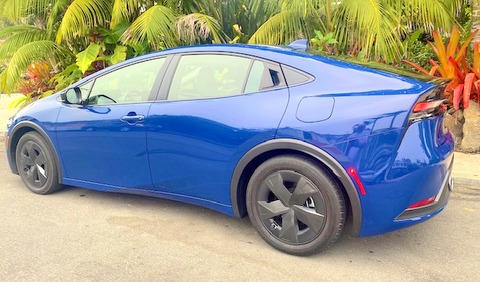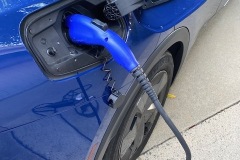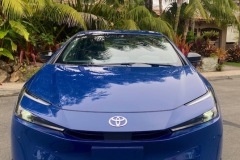The Least Expensive Plug-in Hybrid in America
Smart owners will quickly learn how to maximize the driving range and efficiency of the 2024 Toyota Prius Prime plug-in hybrid vehicle or PHEV. It starts by plugging in every night. If you own a modern phone, this plug-in-before-hitting-the-hay concept isn’t new.

You will awake to a fully charged battery and another 45 miles of all-electric range to get you around town and on short trips without burning a drop of oil. If you need to go further, maybe California to New York, the efficient hybrid engine delivers 52 miles per gallon.
With the Prius Prime PHEV there is no such thing as range anxiety, so take that off your list for not wanting to buy an electrified car. On top of that, the Prius Prime is the lowest cost of the 35 plug-in hybrid models available in 2024 (though the 10 $100,000+ luxury models really don’t offer any competition).
Clean Fleet Report spent a week touring California in the 2024 Toyota Prius Prime SE, which is the base model below the XSE and XSE Premium trims. This review reflects the features and equipment on the SE, occasionally noting upgrades available on the XSE and XSE Premium.

Smooth Seamless Efficiency
The 2024 Prius Prime has a 2.0-liter gasoline engine, running on 87 octane, and two motor generators producing 120 kilowatts for a combined 220 horsepower and 139 pound-feet of torque. Available exclusively with front-wheel drive, the electronically-controlled continuously variable transmission, eCVT, has three driver-selectable drive modes of Normal, Eco and Sport, plus an EV save feature.
The SE scooted to 60 mph in about 6.1 seconds, which is fast enough to merge onto freeways, pass big rigs and slow pokes, and rivals many “sporty” gasoline-powered cars. Once reaching cruising speed, the real reason for owing the Prius Prime becomes apparent.
Handling and Ride
The Prius Prime SE drove with ease, as the eCVT kept usable torque in the proper range for strong acceleration. The SE weighs 3,461 pounds, with 284 pounds of that the 16.6 kWh battery, providing a low center of gravity. Toyota does not market the Prius Prime as a sporty car, but the independent MacPherson strut front and rear multi-link suspension kept us planted to the road.

The low rolling resistance 195/60 Toyo Extensa all-season tires, mounted on 17-inch 5-spoke aluminum alloy wheels, offered adequate grip when cornering hard, but showed their strength on the open road to get maximum fuel efficiency. Wider and more performance-oriented tires would take the Prius Prime up a few notes in handling, but that would defeat the purpose of this car.
Stops were solid and true, with no pedal fade, from the power-assisted ABS disc brakes. The regenerative braking was just strong enough so, when lifting off the accelerator, slowing allowed the Prius Prime to ease into corners without needing to apply the brake pedal.
Regenerative braking converts kinetic energy into electricity when braking or coasting, and stores it in the battery. Driving around town, in stop-and-go rush hour freeway traffic or coasting down hills will recharge the battery.
California Cruising – Getting Through the City

My wife and I departed our house at the beach in South Orange County headed to the wine country of the Santa Ynez Valley, some 200 miles away. When we departed, the fully charged battery and full gas tank said we had 600 miles of driving range, which we confirmed with the EPA. Knowing we were planning trip of about 400 miles, this was nice to see.
Luggage for two easily fit in the 20.3 cubic feet space behind the rear seat. If we needed more, with the 60:40 rear seat back laid down the storage area grows to 26.7 cubic feet. The tonneau cover added a layer of privacy and security for our gear.
One of the most congested intersections in the country, where I-405 and US-101 meet, needed to be negotiated if we were to get out of Los Angeles county. Anyone that has done it knows how tricky it can be with traffic going 70+ mph on 405 jockeying to get into the far right lanes, then slowing to about 20 mph (even less in rush hour) to make the sweeping left curve onto 101. Happy to report we came through unscathed.
California Cruising – Orange County to the Santa Ynez Valley

Traversing the San Fernando Valley from the 405/101 spilt is something you just do, without hesitation or thoughts of stopping to sight-see. Almost at the far west end the valley you will pass under the Wallis Annenberg Wildlife Crossing, being constructed (as of this story in September 2024) over the 101 in Agoura Hills. This long planned and debated overpass is to allow the diverse wildlife that lives in the Santa Monica Mountains to cross safely as it roams for food and mates. Probably the most famous of the local wildlife is Puma P-22, who made world headlines when he was captured on camera in the Hollywood Hills. When he was captured and euthanized two years ago, examinations revealed injuries consistent with being hit by a car, providing further public support for innovations like the overpass.
The balance of this stretch of 101 leads into Ventura County and the first glimpse of the Pacific Ocean. Passing Ventura and the quirky roadside community of La Conchita means Rincon Point is not far ahead.
Straddling Ventura and Santa Barbara counties, Rincon is famous for being one of the best surf spots along the California coast, if not the world. Driving further on 101 leads through Carpenteria, Summerland and Santa Barbara until the turn-off for State Route 154, which leads over the San Marcos Pass into the verdant Santa Ynez Valley.

SR 154 was a good test for the Prius Prime as it goes from sea level to 2,181 feet elevation in about 21 miles. With the battery charge depleted the 2.0-liter four cylinder hybrid was using its 150 horsepower to pull the grade. Straining engine noises filled the cabin. Knowing this would be ending soon, it was tolerable. It’s also something that wouldn’t happen under normal use.
The ocean-view portion of the trip was beautiful but looking down on the Santa Ynez Valley was wonderful. There are two vista points worth stopping at which offer mountain, orchard, vineyard and cattle ranch views, as well as the first sight of Cachuma Lake, a 9,000-acre recreation area constructed in 1953.
But the hidden gem, and a short side-trip, is the Cold Springs Tavern on Stagecoach Road. The history of the tavern, built in 1860, dates back to 1868 when it was used as a stagecoach stop for weary travelers. This has the makings of a romantic story out of the Wild Wild West. If you have the time plan on stopping for lunch and exploring this mostly unknown, but important part of California history.
Los Olivos – The Heart of the Santa Ynez Valley

Los Olivos is now known for its charm, fine dining and winery tasting rooms, all of which there are plenty. Before it was a town, it was a stagecoach stop beginning in 1861. The town was established in 1887 by Aden Alan Boyd, who planted 5,000 olive trees, and named his new property Los Olivos—the olive trees.
We pulled into the Inn at Mattei’s Tavern, a luxury resort that gets its name from the original hotel that was built in 1886 by Felix and Lucy Mattei. Then, it was directly across the street from the depot for the Pacific Coast Railroad. Now, it welcomes guests with a casual-but-elegant respite after a drive from San Francisco or Los Angeles.
The food was excellent, the bed Goldilocks-approved, the relaxing spa with yoga and the pool all made for a luxury stay.

Headed Home
It’s always tough to go home, but after having a pleasant drive a few days earlier, we were anticipating the same for the next 200 miles.
We headed back over the San Marcos Pass and made one stop, which for us is mandatory whenever driving past Santa Barbara—the Helena Avenue Bakery. This artisan bakery makes the most wonderful breads and pastries. For us, the buy is always a couple loaves of their Sourdough Levian; we’re lucky if they make it all the way home.
Is That Really A Prius?
More than one person walked up and asked “What kind of car is that?” Even better, some asked “Is that a Tesla?” This happens occasionally with luxury and exotic cars, but rarely with a compact sedan.

Completely new and redesigned the previous year, the 2024 Prius Prime is the best-looking Prius of all time. Aesthetically pleasing with a longer and wider stance, the profile is one connected sweeping line from the tip of the hood and the LED daytime running lights and bi-LED projector headlights, to the narrow LED tail light band that runs the full width below the rear spoiler. The aerodynamic design has earned a 0.27 Coefficient of drag (Cd), which helps it cut through the wind and deliver excellent fuel economy.
The first time you see the Prius up close, it produces a sense of wondering where this attractive car has been, considering the earlier Prius generations were rarely considered good-looking. Take a look at the photos and get grasp of what the fifth generation Prius has to offer. When you see it at the Toyota dealer in person, the experience will start all over again.
The 2024 Prius Prime is available four colors with no extra charge: Cutting Edge, Guardian Gray, Midnight Black Metallic and Reservoir Blue, while Wind Chill Pearl and Supersonic Red each have a $425 premium. Our Prius Prime, in Reservoir Blue with black aerodynamic wheel covers, had a dark look and feel.
Modern Interior
The very low 5.6-inches of ground clearance translates to a low driving position. Front visibility is good, but the swept-back windshield design may create a minor A-pillar blindspot for some drivers. Rearward, the visibility was good, but if there are no rear seat passengers removing the headrests gives a clear, open sightline.

The interior is clean and uncomplicated, with controls an easy reach for the driver. The dash features two screens: a 7-inch configurable multi-information LCD display located behind the steering wheel, and an 8-inch multimedia display that juts from the center dash. The center screen, includes navigation and six speakers for the SiriusXM/AM/FM radio with wireless Apple CarPlay and Android Auto. A JBL Premium Audio System with eight speakers and an amplifier is standard on the XSE Premium along with a 12.3-inch display.
The audio system usability would have been improved with a channel knob to accompany the volume knob. Six USB ports and Wi-Fi Connect, with an AT&T hotspot, are standard on all models.
The seats are fabric trimmed on the SE and have manual adjustments. We both commented the seats felt thin and did not offer enough thigh, upper back or lumbar support. This may be fine for short commutes and in-town errand driving, but for a car with a 600-mile driving range, owners will be tempted to take lengthy road trips. If that is how you will be using the Prius Prime, then opt for the XSE or XSE Premium that have SofTex-trimmed (a synthetic leather) with power adjustments that include lumbar for the driver.
As with previous Prius models, three adults can fit in the 60:40 folding rear seat. But if two ride along, they get a center armrest with cup holders.
Charging

The Prius Prime SE uses a 13.6 kilowatt-hour lithium-ion battery that delivers 45 miles of all-electric driving range. Charging is by plugging in using the onboard 3.5 kilowatt charger. Toyota supplies the charging cord, so by plugging into a common household outlets these are the charging times going from discharged to a full charge.
120V Level 1 – 11 hours
240V Level 2 – 4 hours
Even at the Level 1 charge rate, the battery will be topped off by plugging in it at bedtime, just like you do every night with a mobile phone. There is no mystery about how to stay away from gasoline stations for the majority of your driving.
The Prius Prime does not come with a 480V Quick Charge option.
Safety

The 2024 Prius is equipped with advanced driver assistance systems (ADAS) packaged as Toyota Safety Sense 3.0. Active and passive safety features include eight air bags, vehicle stability and traction control, brake assist and blind spot monitor with rear cross-traffic alert.
The advanced driver pre-collision technology includes lane departure alert, adaptive cruise control and pedestrian detection. Additional safety features include remote keyless entry, push button start/stop, a tire pressure monitoring system, Remote Connect, Safety Connect, and Drive Connect.
Warranties
- Comprehensive – Three years/36,000 miles
- Powertrain – Five years/60,000 miles
- Hybrid Components – 10 years/150,000 miles
- Complimentary Maintenance – Two years/25,000 miles
- Roadside Assistance – Three years/Unlimited Miles
Pricing
There are three grades, with these base prices, including the $1,095 delivery fee.
- SE $34,070
- XSE $37,320
- XSE Premium $40,765
Observations: 2024 Toyota Prius Prime SE
No car company makes and sells more hybrids than Toyota. The gasoline-electric Prius was the first mass-produced hybrid vehicle to go on sale in Japan in 1997, debuting in the U.S. in 2000 just after the Honda Insight. Toyota sells the Prius in more than 90 markets. The United States is its largest market.

So this makes the case for Toyota not messing with a good thing, but they did just that and have delivered a Prius that makes people go “Ooooo!” The old wedge shape with harsh angles is gone, transitioning to a sleek and aerodynamic high mileage and very appealing sedan.
Then in 2012 Toyota introduced the Prius Prime plug-in gasoline-electric hybrid taking efficiency and driving range to the next level. The 40 – 45 mile all-electric driving range, depending on which trim, means for most people their daily commute can be completed without using any gasoline. But then when a longer road trip is being planned the Prius Prime delivers hybrid efficiency.
This is the reason a plug-in hybrid is an excellent option for those not quite ready to go to a full electric car. It is also the reason so many other car companies have added a PHEV to their line-up.
Ed. Note: Toyota has been using the “Prime” moniker with its Prius and RAV4 plug-in hybrids. They have announced that starting with the 2025 models they will just be branded as Plug-in Hybrid, although Toyota also refers to them as Plug-in Hybrid EVs (for Electrified Vehicle as opposed to an Electric Vehicle).
Make sure to opt-in to the Clean Fleet Report newsletter (top right of page) to be notified of all new stories and vehicle reviews.
Story by John Faulkner. Photos by John Faulkner and Toyota.
PHEVs are surging in popularity; here’s some we’ve tested:
Road Test: 2024 Alfa Romeo Tonale PHEV
Road Test: 2021 BMW 330e PHEV
Road Test: 2016 BMW X5 xDrive40e PHEV
News: BMW XM Revealed
Road Test: 2022 Chrysler Pacifica PHEV
Road Test: 2024 Dodge Hornet PHEV
Road Test: 2022 Ford Escape PHEV
Road Test: 2022 Jeep Grand Cherokee 4×3 PHEV
Road Test: 2021 Jeep Wrangler 4xe PHEV
Road Test: 2023 Kia Niro PHEV
Flash Drive: 2023 Kia Sportage
Road Test: 2023 Land Rover Range Rover Sport PHEV
Flash Drive: 2022 All-New Lexus NX
Flash Drive: 2023 Lexus RX 500h+ PHEV
Road Test: 2022 Lincoln Corsair PHEV
Flash Drive: 2025 Mazda CX-70 PHEV
Flash Drive: 2024 Mazda CX-90 PHEV
Flash Drive: 2023 Mitsubishi Outlander PHEV
Road Test: 2023 Toyota RAV4 Prime PHEV
Road Test: 2023 Volvo XC60 Recharge PHEV
Road Test: 2021 Volvo XC90 Recharge PHEV
Disclosure
Clean Fleet Report is loaned free test vehicles from automakers to evaluate, typically for a week at a time. Our road tests are based on this one-week drive of a new vehicle. Because of this we don’t address issues such as long-term reliability or total cost of ownership. In addition, we are often invited to manufacturer events highlighting new vehicles or technology. As part of these events we may be offered free transportation, lodging or meals. We do our best to present our unvarnished evaluations of vehicles and news irrespective of these inducements.
Our focus is on vehicles that offer the best fuel economy in their class, which leads us to emphasize electric cars, plug-in hybrids, hybrids and other efficient powertrains. We also feature those efficient gas-powered vehicles that are among the top mpg vehicles in their class. In addition, we aim to offer reviews and news on advanced technology and the alternative fuel vehicle market. We welcome any feedback from vehicle owners and are dedicated to providing a forum for alternative viewpoints. Please let us know your views at publisher@cleanfleetreport.com.















